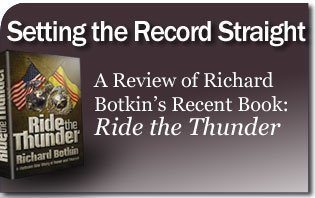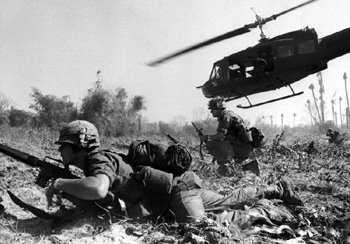 One of the most cited and least understood wars in American history is Vietnam. Due to these misunderstandings, it has become synonymous with the words quagmire and disaster.
One of the most cited and least understood wars in American history is Vietnam. Due to these misunderstandings, it has become synonymous with the words quagmire and disaster.
Thus, opponents of current military campaigns in Iraq and Afghanistan decry our operations there saying that America is getting itself into “another Vietnam.” However, were US military activities in Southeast Asia really so bad after all?
The answer is yes and no: Yes, they were certainly a worldwide embarrassment as our troops left the field of battle without victory. However, judged by the performance of America’s military, the answer must be a resounding no. Sadly, politicians, not warriors, decided the outcome.
Thus, the true story of the American soldiers’ valor must be told. Such was the task of Richard Botkin in his recent 650-page tome, Ride the Thunder: A Vietnam War Story of Honor and Triumph. In it, he successfully fulfills this task by doing exactly what his title suggests: telling the story of the Vietnam War in terms of honor and triumph.
The book primarily focuses on three Marine heroes: Colonel John W. Ripley, USMC, Lieutenant Colonel Gerald Turley, USMC and Vietnamese Lieutenant Colonel Le Ba Binh. In telling their stories, Mr. Botkin seamlessly intertwines a retelling of the history of the entire Vietnam War. His work is painstakingly researched, yet highly readable.
Certain points stand out among the many details of the book. First among these is the immense suffering that the Vietnamese people suffered at the hands of the Communists. Mr. Botkin vividly demonstrates this with incidents of the North Vietnamese Army’s (NVA) intentional targeting of innocent civilians.

After the end of the war, more challenges awaited the devastated South, including persecution from their Northern captors. This included the creation of “reeducation” camps throughout the country. Despite their inconspicuous label, these camps had nothing to do with regaining lost knowledge. As Mr. Botkin points out, the installation of these camps “was nothing more than organized revenge on a massive scale.” (p. 548)
Ride the Thunder includes the story of how Lieutenant Colonel Le Ba Binh was forced to spend more than eight years in one such camp, during which time he was allowed less than two hours total visit time with his family.
Another important point Mr. Botkin highlights is the military success the American and South Vietnamese armies enjoyed throughout the war. He convincingly dispels many media-created myths that Vietnam was a lost cause.
The fact is that American forces did not lose a single battle of any consequence in the entire war, in spite of their self-defeating policy that allowed the enemy free communications along the Ho Chi Minh Trail and safe havens in Laos, Cambodia and North Vietnam. Even the oft-touted Tet Offensive of 1968 was a very real defeat for the NVA.
Despite the operation’s enormous scope, South Vietnamese and American forces had already regrouped and began a counterattack within hours of its first salvos. They were so successful that other than continued fighting in Hue and Khe Sanh, the entire offensive was defeated within two weeks. In Hue, expelling the Communists took twenty-seven days, while the enemy eventually abandoned Khe Sanh as well.
Therefore, the North Vietnamese did not gain any ground and loss an estimated 45-50,000 troops KIA during the offensive. Many more thousands were captured. (American deaths during the entire war are estimated at around 58,000.)
All-in-all, military leadership classified the operation as a tremendous victory. The only Communist victory of the campaign had been fought for America’s soul. As Mr. Botkin described it: “the Communist offensive did achieve a public relations coup with the American public well beyond what a militarily defeated [NVA] could have possibly dreamed.” (p. 146)
However, a Communist operation in March of 1972 dwarfed Tet in size, aggressiveness and overall danger to South Vietnam. Dubbed the Easter Offensive, it began with a simultaneous attack on twelve bases that spanned the entire length of the Demilitarized Zone (DMZ). From its very beginning, all known friendly artillery positions came under attack.
With American troops already largely withdrawn, the objective seemed obvious and frighteningly obtainable: break through the South’s weak defensive lines and drive southward to Saigon, thus winning the war and subjecting all of Vietnam to communist domination.
Fortunately for the South, the Communist troops met unbelievable resistance that was greatly aided by the actions of three tough Marine officers who refused to give up.
The first was Vietnamese Lieutenant Colonel Binh, whose battalion (known as Soi Bien or “Wolves of the Sea”) held the ground defending a bridge across the Cua Viet River at the city of Dong Ha. The bridge was highly strategic because it was the only crossing in the area sturdy enough to support the more than 200 tanks the NVA had assembled on the north side of the river.
Lieutenant Colonel Binh persistently held his ground in spite of overwhelming odds. It was his training and leadership that kept the situation together in Dong Ha as his men faced the fight of their lives.
The Lieutenant Colonel’s determination is well demonstrated in a radio message he sent out to his commanders when rumors began to circulate that Dong Ha had fallen. He said:
It is rumored that Dong Ha has fallen…My orders are to hold the enemy in Dong Ha. We will fight in Dong Ha. We will die in Dong Ha. We will not leave. As long as one Marine draws a breath of life, Dong Ha will belong to us. (pp. 327-328)
While the desperation of the situation led scores of South Vietnamese troops throughout the DMZ to desert, not a man of the Soi Bien left his post.
Their efforts supported American Colonel John W. Ripley, then serving with Colonel Binh as an advisor. He would need all the help he could get as he took on a mission to destroy the Dong Ha Bridge, in an endeavor so daring that it has become part of Marine Corps legend.
The bridge’s superstructure was a hulking construction that had been made by American Seabees. It was supported by six enormous I-beams three feet tall. To destroy it, Colonel Ripley would have to hand-walk and crawl 500 pounds of TNT and plastic explosives one hundred feet into its underbelly. All the while, he would be submitted to continual enemy fire. His difficulties were multiplied by the sleep and food deprivation he had suffered throughout the previous days.
The feat was so difficult that no one believed survival, let alone successful completion, was possible. Nevertheless, after hours of intense physical exertion, everything had been put in place, the charges were detonated and the bridge was no more. Colonel Ripley was awarded the Navy Cross for his actions that day.
Some historians have argued that the destruction of that bridge was the single most important factor that postponed the defeat of South Vietnam until 1975.
However, there is another individual on whose shoulders the defense of South Vietnam during the Easter Offensive weighed heavily, but who has received insufficient historic recognition so far. That is why Mr. Botkin’s description of the role played by Lieutenant Colonel Gerald Turley is of particular value.
When the Lieutenant Colonel chose to return to Vietnam in 1971, there were only about one thousand Marines still on the ground. Since President Nixon’s policy of “Vietnamization” was fully underway, the brunt of the fighting was being born by Vietnamese soldiers. That is why Lieutenant Colonel Turley fully expected to see little if any action during this, his second tour.
His role as assistant senior Marine advisor would consist in helping senior Marine advisor Colonel Josh Dorsey and perhaps filling in for him from time to time. As such, he would live in Saigon, which, at the time, was far removed from combat. The closest he imagined he would come to actual fighting was an occasional and uneventful visit to the frontlines.
His expectations were shattered when, on a four-day visit to I Corps Tactical Zone, the Easter Offensive broke out. He happened to be at 3rd ARVN Division forward headquarters at Ai Tu when the Army officer in charge there began suffering nervous problems, abandoned his post and ordered Lieutenant Colonel Turley to take the helm.
Worse yet, communications with higher leadership in Saigon were practically nonexistent, meaning this change in command went unreported. In addition to facing the largest Communist advance of the entire war, Lieutenant Colonel Turley also had to confront hostile and mistrustful leaders, who continually second guessed his decisions and attempted to countermand many of his orders. The situation was so desperate, he was forced to take responsibility for disregarding some of the directives he received from higher-ups.
While other players in the offensive faced their predicament with the support of their leaders, expecting praise if they survived, Lieutenant Colonel Turley could only anticipate disciplinary action and perhaps court martial.
Even when he ordered Colonel Ripley to destroy the Dong Ha Bridge, he did so against the direct wishes of his commanders. However, the reality of over two hundred tanks about to cross the Cua Viet River and invade South Vietnam was too dangerous for him to accept when he had the possibility to prevent it.
In spite of having no food, virtually no sleep and a severe case of dysentery, he faced the opposition of his superiors and stood by his post, directing air, naval and ground operations that salvaged a desperate situation. He continued in this capacity for a full four days until he was ordered back to headquarters for questioning. The physical, psychological and moral stress he faced during this time can hardly be imagined.
Nevertheless, he survived and emerged as one of the greatest examples of “honor and triumph” of the entire war.
The stories of these three heroes and much more are included in Rich Botkin’s Ride the Thunder. This makes it a must-read for all military-loving Americans and especially those who are interested in knowing the true history of the Vietnam War — one not tainted by politically correct historians intent on criticizing America and especially its military.
However, readers should be warned that Mr. Botkin’s book, while less offensive than many military volumes, does have its share of profanity, which he mostly limited to the contents of direct quotes from characters in the book. Similarly, there are references, though not graphic, to those activities that have unfortunately been so closely linked with soldiers throughout history.
Nevertheless, Ride the Thunder is an exciting and highly informative read. No military library is complete without it. Above all, it does what needs to be done: It sets the record straight.
Ride the Thunder: A Vietnam War Story of Honor and Triumph
Hardcover: 688 pages
ISBN-10: 193507105X
ISBN-13: 978-1935071051
Average Customer Review: 4.9 out of 5 stars

